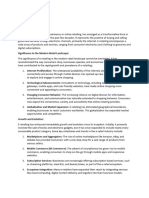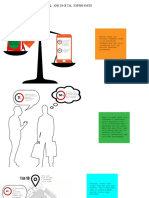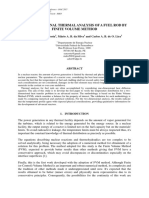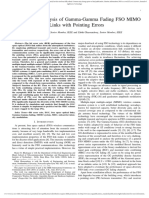Online Shopping's Influence on Physical Retail Visits
“A Comprehensive Study on the Transformative Shift in Consumer
Behaviour”
-----------------------------------------------------------------------------------
Prepared by:
Group Members:
M. Haris Khan (13496)
Areeba Malik (13779)
Ammara Rasheed (13633)
Rishayl Mirza (14038)
Sheikh Muhammad Anees (13277)
-----------------------------------------------------------------------------------
Submitted to:
Sir: Dr. Atif Aziz
Page 1 of 17
� Abstract:
The rise of online shopping has significantly impacted physical retail visits, leading to a
transformative shift in consumer behaviour and retail operations. This article examines the
decline in traditional foot traffic attributed to the convenience and advantages of online
shopping, such as wider product selection, competitive pricing, and home delivery. To counteract
this trend, many retailers have adopted omnichannel strategies, integrating online and offline
operations to provide seamless customer experiences, exemplified by the "buy online, pick up in-
store" (BOPIS) model. The article also explores how enhancing the in-store experience through
personalized services, immersive environments, and technologies like augmented reality (AR)
and virtual reality (VR) can attract and retain customers. The impact of mobile shopping and
behaviours such as "showrooming" and "webrooming" are discussed, along with the emergence
of experiential retail, which focuses on creating memorable in-store experiences. The use of data-
driven personalization to tailor customer interactions and the resilience of certain retail segments,
such as grocery stores and luxury goods, are also highlighted. Despite the challenges posed by
the rise of online shopping, the article concludes that physical stores can thrive by innovating and
harmonizing online and offline channels to create engaging and integrated shopping experiences
for consumers.
Introduction:
The rise of online shopping has revolutionized the retail landscape, leading to significant changes
in consumer behaviour and the operations of brick-and-mortar stores. This transformation, driven
by technological advancements and changing consumer preferences, has had profound effects on
physical retail visits. While some may view online shopping as a threat to traditional retail, a
more nuanced understanding reveals a complex relationship that includes both challenges and
opportunities for physical stores.
1. The Erosion of Traditional Foot Traffic:
One of the most noticeable impacts of online shopping is the decline in foot traffic to physical
stores. Consumers are increasingly drawn to the convenience of browsing and purchasing
products from the comfort of their homes. This shift is particularly evident in certain retail
sectors, such as electronics, books, and clothing, where online platforms often offer a wider
selection, competitive pricing, and the convenience of home delivery.
Page 2 of 17
�2. The Role of Omnichannel Strategies:
To combat the decline in physical store visits, many retailers have adopted omnichannel
strategies, integrating their online and offline operations. This approach allows customers to
enjoy the best of both worlds. For instance, the "buy online, pick up in-store" (BOPIS) model has
gained popularity, encouraging customers to visit physical stores to collect their online orders.
This not only drives foot traffic but also presents opportunities for additional in-store purchases.
3. Enhancing the In-Store Experience:
Physical retailers are increasingly focusing on enhancing the in-store experience to differentiate
themselves from online competitors. This includes offering personalized services, creating
immersive shopping environments, and leveraging technology such as augmented reality (AR)
and virtual reality (VR). By providing unique and engaging experiences, physical stores can
attract customers and encourage repeat visits.
4. The Impact of Mobile Shopping:
The proliferation of smartphones has further blurred the lines between online and offline
shopping. Mobile shopping apps and mobile-optimized websites allow consumers to shop
anytime, anywhere. This convenience has led to a phenomenon known as "showrooming," where
customers visit physical stores to view and try products before purchasing them online, often at
lower prices. Conversely, "webrooming" occurs when customers research products online before
buying them in-store. Retailers need to adapt to these behaviours by providing seamless and
integrated shopping experiences across all channels.
5. The Emergence of Experiential Retail:
In response to the rise of online shopping, some physical retailers are pivoting towards
experiential retail. This concept involves creating stores that offer more than just products; they
provide experiences. Examples include in-store events, workshops, and interactive displays. By
transforming shopping into a memorable activity, retailers can drive foot traffic and build
stronger connections with customers.
6. Data-Driven Personalization:
Online retailers have long leveraged data analytics to personalize shopping experiences and
marketing efforts. Physical retailers are now adopting similar strategies, using data to understand
customer preferences and behaviours. By collecting and analysing data from various touchpoints,
retailers can offer personalized recommendations, targeted promotions, and tailored in-store
experiences, thereby enhancing customer satisfaction and loyalty.
7. The Resilience of Certain Retail Segments:
While online shopping has disrupted many retail sectors, some segments remain resilient.
Grocery stores, for example, continue to see strong physical foot traffic, as many consumers
prefer to select fresh produce and perishable items in person. Additionally, luxury goods and
Page 3 of 17
�high-end fashion brands often rely on in-store visits to provide personalized service and
exclusive experiences that are difficult to replicate online.
Conclusion:
The influence of online shopping on physical retail visits is undeniable, marking a transformative
shift in the retail industry. While traditional retailers face challenges such as declining foot traffic
and increased competition, they also have opportunities to innovate and adapt. By embracing
omnichannel strategies, enhancing the in-store experience, leveraging mobile technology, and
focusing on experiential retail and data-driven personalization, physical stores can continue to
play a vital role in the modern retail ecosystem. Ultimately, the future of retail lies in the
harmonious integration of online and offline channels, creating a seamless and engaging
shopping journey for consumers.
Background Of the Study:
The retail landscape has undergone significant changes over the past few decades, largely driven
by advancements in technology and shifts in consumer behaviour. The emergence and
proliferation of the internet in the late 20th century laid the groundwork for the development of
e-commerce, fundamentally altering the way people shop. Online shopping platforms have since
grown exponentially, offering consumers unprecedented convenience, variety, and competitive
pricing.
Historically, physical retail stores were the primary venues for purchasing goods. Consumers
visited these stores not only to buy products but also to engage in social interactions and seek
personalized services. The traditional retail model relied heavily on foot traffic and in-store
purchases, with location and customer service being key competitive advantages.
With the advent of online shopping, these dynamics began to shift. E-commerce giants like
Amazon and Alibaba capitalized on the internet's reach to offer a vast array of products and
services, often at lower prices due to reduced overhead costs. This created a new competitive
landscape where convenience and price became paramount. The ability to shop from anywhere,
at any time, without geographical constraints, significantly altered consumer expectations and
behaviours.
As online shopping gained popularity, physical retailers started feeling the pressure. Declining
foot traffic became a critical issue, prompting many to rethink their business models. The rise of
mobile technology further accelerated this trend, allowing consumers to shop on-the-go, compare
prices, read reviews, and make purchases directly from their smartphones.
In response to these challenges, traditional retailers began exploring various strategies to adapt
and survive. Omnichannel retailing emerged as a key approach, integrating online and offline
Page 4 of 17
�experiences to provide a seamless shopping journey. Innovations such as "buy online, pick up in-
store" (BOPIS), personalized in-store services, and the incorporation of advanced technologies
like augmented reality (AR) and virtual reality (VR) started to redefine the role of physical
stores.
Additionally, the concept of experiential retail gained traction, focusing on creating unique,
engaging, and memorable in-store experiences that could not be replicated online. This shift
aimed to draw customers back into stores by offering added value beyond the mere transaction of
goods.
Despite these efforts, the retail industry continues to navigate a complex landscape where the
lines between online and offline shopping are increasingly blurred. Understanding the nuanced
impacts of online shopping on physical retail visits is crucial for retailers to devise effective
strategies that leverage the strengths of both channels. This study aims to delve into these
impacts, exploring how retailers can innovate and adapt to maintain relevance and thrive in an
ever-evolving market.
Responses:
Page 5 of 17
�Page 6 of 17
�Page 7 of 17
�Page 8 of 17
� Problem Statement:
The rapid growth of online shopping has created significant challenges for traditional brick-and-
mortar retailers, leading to a decline in physical store visits and necessitating a revaluation of
retail strategies. This shift in consumer behaviour threatens the viability of many physical stores,
which historically relied on foot traffic and in-person sales to drive revenue. The main problem
lies in understanding how physical retailers can adapt to this changing landscape, integrate online
and offline channels effectively, and develop innovative strategies to attract and retain customers
in a highly competitive market.
Key issues to address include:
1. Declining Foot Traffic: How can physical stores combat the decrease in in-store visits caused
by the convenience and advantages of online shopping?
2. Omnichannel Integration: What are the best practices for integrating online and offline
operations to provide a seamless shopping experience?
3. Enhanced In-Store Experiences: How can physical retailers leverage technology and
personalized services to create compelling and unique in-store experiences that attract
customers?
4. Mobile Shopping Impact: What strategies can physical retailers employ to mitigate the
effects of mobile shopping behaviours such as "showrooming" and "webrooming"?
5. Experiential Retail: How can the concept of experiential retail be effectively implemented to
transform physical stores into destinations that offer more than just products?
6. Data-Driven Personalization: How can physical retailers use data analytics to understand
customer preferences and tailor in-store experiences and marketing efforts accordingly?
7. Resilience of Specific Segments: Which retail segments are more resilient to the impacts of
online shopping, and what lessons can be learned from their success?
Addressing these issues is crucial for physical retailers to maintain relevance and
competitiveness in an increasingly digital retail environment. This study seeks to explore these
challenges in depth and provide actionable insights for retailers to innovate and thrive amidst the
ongoing evolution of the retail industry.
Page 9 of 17
� Research Questions:
To explore the impact of online shopping on physical retail visits and to identify strategies for
traditional retailers to adapt and thrive in this evolving landscape, the following research
questions are proposed:
1. Decline in Foot Traffic:
- What are the primary factors contributing to the decline in physical store visits due to the rise
of online shopping?
- How do different retail sectors vary in terms of the impact of online shopping on foot traffic?
2. Omnichannel Integration:
- What are the most effective omnichannel strategies that retailers can implement to bridge the
gap between online and offline shopping experiences?
- How do customers perceive and engage with omnichannel retail models like "buy online,
pick up in-store" (BOPIS)?
3. Enhanced In-Store Experiences:
- What technologies (e.g., augmented reality, virtual reality) can enhance the in-store shopping
experience, and how effective are they in attracting customers?
- What role does personalized customer service play in enhancing the in-store experience and
driving repeat visits?
4. Mobile Shopping Impact:
- How do behaviours such as "showrooming" (viewing products in-store before buying online)
and "webrooming" (researching products online before buying in-store) affect physical retail
sales?
- What strategies can physical retailers employ to counteract the negative impacts of these
mobile shopping behaviours?
Page 10 of 17
�5. Experiential Retail:
- What are the key components of a successful experiential retail strategy that can make
physical stores destinations for customers?
- How do experiential retail strategies influence customer loyalty and brand perception?
6. Data-Driven Personalization:
- How can physical retailers effectively use data analytics to understand customer preferences
and behaviours?
- What are the best practices for implementing data-driven personalization in physical stores to
enhance the shopping experience?
7. Resilience of Specific Segments:
- Which retail segments (e.g., grocery, luxury goods) are more resilient to the rise of online
shopping, and why?
- What lessons can be learned from the strategies employed by these resilient segments to
mitigate the impact of online shopping on physical store visits?
By addressing these research questions, the study aims to provide comprehensive insights into
the challenges and opportunities faced by physical retailers in the digital age and to suggest
practical strategies for adapting to the changing retail environment.
Page 11 of 17
� Research Objectives:
The overarching goal of this study is to understand the influence of online shopping on physical
retail visits and to identify strategies for traditional retailers to adapt and thrive in this evolving
landscape. The specific research objectives are:
1. Analyse Declining Foot Traffic:
- To identify and analyse the primary factors contributing to the decline in physical store visits
due to the rise of online shopping.
- To examine how different retail sectors are variably impacted by the decline in foot traffic.
2. Evaluate Omnichannel Strategies:
- To investigate the effectiveness of various omnichannel strategies in integrating online and
offline shopping experiences.
- To assess customer perceptions and engagement with omnichannel retail models such as "buy
online, pick up in-store" (BOPIS).
3. Enhance In-Store Experiences:
- To explore the potential of technologies like augmented reality (AR) and virtual reality (VR)
in enhancing the in-store shopping experience.
- To evaluate the impact of personalized customer service on the in-store experience and
customer retention.
4. Assess Mobile Shopping Behaviours:
- To analyse the effects of mobile shopping behaviours such as "showrooming" and
"webrooming" on physical retail sales.
- To develop strategies for physical retailers to mitigate the negative impacts of these mobile
shopping behaviours.
Page 12 of 17
�5. Implement Experiential Retail:
- To identify the key components of successful experiential retail strategies that transform
physical stores into customer destinations.
- To evaluate the influence of experiential retail on customer loyalty and brand perception.
6. Utilize Data-Driven Personalization:
- To explore how physical retailers can effectively use data analytics to understand customer
preferences and behaviours.
- To identify best practices for implementing data-driven personalization in physical stores to
enhance the shopping experience.
7. Examine Resilient Retail Segments:
- To identify retail segments that are more resilient to the rise of online shopping and
understand the reasons for their resilience.
- To derive lessons from the strategies employed by these resilient segments that can be applied
to other retail sectors.
By achieving these objectives, the study aims to provide a comprehensive understanding of the
challenges and opportunities posed by the rise of online shopping and to offer actionable insights
for traditional retailers to adapt and succeed in the digital age.
Page 13 of 17
� Hypothesis:
Independent Variable (IV): “Rise of online shopping”
Explanation: There is any increase in the availability and usage of online platforms for
purchasing goods and services, which can be measured by factors such as the volume of
online sales, the number of e-commerce platforms, and the growth rate of online retailing.
Dependent Variable (DV): “Foot traffic to physical retail stores”
Explanation: There is any change in the number of customers visiting physical retail
stores, which can be measured by foot traffic counts, sales data from physical stores, and
in-store customer visits.
Definitions:
Online Shopping’s:
Online shopping's convenience and accessibility have revolutionized the retail landscape,
allowing consumers to purchase goods and services from the comfort of their homes. This shift
has led to a significant increase in the number of transactions conducted online, driven by the
vast selection of products, competitive pricing, and the ability to compare items quickly.
Furthermore, online shopping's impact extends beyond consumer habits; it has transformed
supply chain logistics, marketing strategies, and even the structure of physical retail spaces. As a
result, businesses are continually adapting to meet the evolving demands of online shoppers,
emphasizing the importance of a strong online presence and efficient digital operations
.
Physical Retail Visit:
As a variable, "physical retail visit" refers to the act of a consumer going to a brick-and-mortar
store to browse, purchase, or inquire about products or services. In studies or analyses, this
variable is crucial for understanding consumer behaviour and preferences in contrast to online
shopping. Measuring physical retail visits can provide insights into foot traffic trends, the
effectiveness of in-store promotions, and the overall health of physical retail locations.
For instance, in examining the impact of online shopping, researchers might analyse the
"physical retail visit" variable to determine how the convenience and appeal of e-commerce
affect the frequency and nature of in-person shopping trips. By tracking changes in this variable,
Page 14 of 17
�businesses can adjust their strategies to enhance the in-store experience, align inventory with
customer needs, and integrate their physical and digital operations more effectively.
Past Literature:
The impact of online shopping on physical retail visits has been extensively studied across
various dimensions, providing a rich body of knowledge from which this research can draw. The
following is a summary of relevant literature that informs the present study:
1. Decline in Foot Traffic:
Several studies have documented the decline in physical store visits as online shopping has
gained traction. Burt and Sparks (2003) noted early on that e-commerce was beginning to shift
consumer behaviours away from traditional shopping habits. Later, Rigby (2011) highlighted the
growing preference for online shopping due to its convenience, broader selection, and
competitive pricing. Recent research by Gallino and Moreno (2014) shows a clear correlation
between the rise of online retail and the decline in foot traffic in various retail sectors.
2. Omnichannel Strategies:
The integration of online and offline channels has been a focal point in recent retail strategy
literature. Brynjolfsson, Hu, and Rahman (2013) discussed the emergence of the omnichannel
retailing paradigm and its potential to create seamless shopping experiences. Verhoef, Kannan,
and Inman (2015) further elaborated on the importance of integrating digital and physical
channels, emphasizing the need for a unified customer experience. Bell, Gallino, and Moreno
(2014) provided empirical evidence on the success of BOPIS in driving foot traffic back to
physical stores.
3. Enhanced In-Store Experiences:
Research has shown that enhancing the in-store experience can attract customers and mitigate the
impact of online shopping. Grewal, Levy, and Kumar (2009) suggested that personalized
services and interactive store environments play a significant role in engaging customers.
Pantano and Di Pietro (2012) explored the use of technologies such as AR and VR in retail,
demonstrating their potential to create immersive shopping experiences that can draw customers
to physical stores.
Page 15 of 17
�4. Mobile Shopping Impact:
The proliferation of smartphones has significantly influenced shopping behaviours. Rapp, Baker,
Bachrach, Ogilvie, and Beitelspacher (2015) investigated the concept of "showrooming" and its
implications for physical retailers. Their findings indicate that while showrooming poses
challenges, it also offers opportunities for retailers to engage customers through mobile-
optimized websites and apps. Gensler, Neslin, and Verhoef (2017) examined "webrooming,"
revealing that many consumers still prefer to complete their purchases in physical stores after
researching online.
5. Experiential Retail:
The shift towards experiential retail has been highlighted as a key strategy for physical stores.
Pine and Gilmore (1998) introduced the concept of the "experience economy," suggesting that
businesses should create memorable events for their customers. More recent studies by Kim,
Sullivan, and Forney (2007) and Hwang and Kandampully (2012) have demonstrated that
experiential retailing can enhance customer satisfaction and loyalty, driving repeat visits to
physical stores.
6. Data-Driven Personalization:
The use of data analytics to personalize customer experiences has been well-documented in retail
literature. Davenport, Mule, and Lucker (2011) discussed the rise of big data and its applications
in retail, highlighting how data-driven insights can improve customer engagement and sales.
Wedel and Kannan (2016) further emphasized the importance of personalized marketing and the
role of data analytics in understanding and predicting customer behaviour.
7. Resilience of Specific Retail Segments:
Some retail segments have shown resilience to the rise of online shopping. Hult, Pride, and
Ferrell (2012) discussed how grocery stores, due to their focus on fresh and perishable items,
maintain strong physical foot traffic. Kapferer and Bastien (2012) examined the luxury goods
sector, noting that high-end brands often rely on in-store experiences to provide the personalized
service and exclusivity that their customers expect.
Page 16 of 17
�Conclusion:
The existing literature provides a comprehensive understanding of the multifaceted impact of
online shopping on physical retail visits. It underscores the importance of omnichannel
strategies, enhanced in-store experiences, mobile optimization, experiential retail, data-driven
personalization, and the resilience of certain retail segments. Building on these insights, this
study aims to further explore and synthesize strategies that traditional retailers can adopt to
navigate and thrive in the evolving retail landscape.
Page 17 of 17























































































